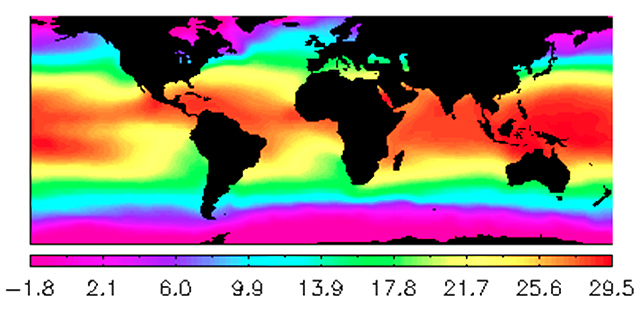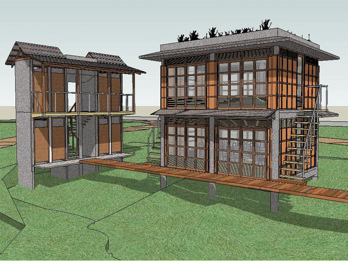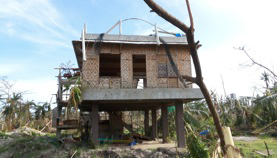SUMMARY
This is AI generated summarization, which may have errors. For context, always refer to the full article.
A scientific study conducted by the US National Oceanographic and Atmospheric Administration (NOAA) shown in the map below reveals the Earth’s sea surface temperatures. Notice the dark red portion on the right side of the map? There lies the hottest sea surface temperature. Notice which country lies right in the middle of it? Isn’t that our precious chain of 7,100 islands known as The Philippines? So what does this map mean?

This means that:
1. Warm water is the fuel of typhoons. The hotter the sea surface temperature, the greater the fuel for typhoons. This is the cause of the more frequent and more intense typhoons in the Philippines.
2. The warmer the seawater, the greater is the evaporation. The greater the evaporation, the more water vapor collects in the clouds, the process called condensation. Since everything that goes up must come down, this explains the much greater volume of rainfall in the Philippines and in Asia, resulting in more and more flooding.
3. The sea east of the Philippines is also experiencing the highest rate of sea level rise. This was verified by a 15-year study by the US National Aeronautics and Space Administration (NASA).
This is not rocket science. It is pure and simple common sense – sense that seems to escape our so-called leaders. We say ‘so-called’ because save for a handful of them, most of our elected leaders appear to “clueless, spineless, gutless, and heartless.” Not to mention that “their heads and their butts are interchangeable,” with no noticeable difference.
Clear and simple science tells us that this is the new reality. The Typhoon Yolandas, Pablos, and Ondoys, and even the inundating habagats (southwest monsoon) are not isolated atmospheric events. They are the new reality and will only get worse as the atmosphere of the Earth continues to heat up. It is like having diabetes. When we are diagnosed with it, the first order of business is to accept it, and then commit to reverse it, or live it with the least inconvenience to our well-being. Unless we understand this and accept this new reality, we will continue to be the victims of these (un) natural calamities. They are not natural calamities. They are all caused by the creature that claims to be the wisest animal on Earth: Humans.
So what do we do?
Rain gardens as a measure against floods
Why is there flooding? Quite simply because excess water has no place to go. Since flooding is the new ‘state of the world’, we must find a place for the excess water to go. In the natural state, that is the function of lakes, ponds, and wetlands. But what did smart human do. We filled them up and paved them over with concrete. And then we complain of floods.
To reverse this, we must open up lands, even small portions, to put up rainwater catchment ponds, wetlands, and rain gardens. First, these will only capture and store excess waters that cause flooding. Then, it will restore the water into the underground water table, also known as the aquifer.
As we know by now, land is subsiding because we have been sucking out too much water from the groundwater table without replenishing it. This is exactly what rain gardens can do. It replenishes the groundwater table, the aquifer.
Filipinizing the term ‘storm surges’
Those of us in the field of environmental studies have long known about storm surges, at least in theory. They are tsunami-like waves caused by powerful winds.
However, the reality did not dawn upon me until December of 2009. During an amihan (northeast monsoon), the waves of the sea in front of my little house on the coast of Bantayan Island washed up to shore and went all the way up to the road, about 200 meters inland.
Knowing this and seeing the more intense flooding occurring in the island, we decided to rebuild our home with a hundred-meter setback from the shoreline. We also dug a man-made mangrove area/wetland/rainwater catchment pond between the shoreline, now locally known as the Climate Change House. More on this later.
When PAGASA warned about Yolanda’s “7-meter storm surges,” no one understood what it meant. The people of Tacloban are used to storms and typhoons. But they had no idea they faced a tsunami.
We should coin a word for this new reality of “storm surges.” For lack of a better word at the moment, the Tagalogs can call it “Tsu-alon”. For us Bisayans, we can call it “Tsu-balod”. It can mean ‘a wave (alon/balod) that is like a tsunami.’
Call it by whatever term, but what is important is that it has a name understood by our minds and hearts. Only then can we prepare for it.
Secure water and food source
Our total dependence on piped running water makes us most vulnerable to electrical shutdowns caused by floods or typhoons. We must go back to basics. The oldfashioned atabay (in Bisaya) or balon (in Tagalog) must be a mainstay in all communities, even in high-end residential communities. In the event of ever-frequent emergencies, they will be the most valuable source of water, a most valuable source of life.
Rice versus root crops and vegetables
One of the greatest myths of human civilization is the myth of rice. It is not only nutritionally useless it is also very harmful to health. Nutritionists tell us that one cup of rice has the sugar content (technically known as the glycemic index) equivalent to 8 spoons of sugar. That is why people who have diabetes are not supposed to eat rice.
The ecological costs of cultivating rice are extremely high. Wetlands, which are supposed to absorb excess waters, are converted into rice paddies that emit methane – a very hot gas that is one of the causes of the ongoing global heating. In addition, there is the intensive need for water to irrigate rice paddies, the constant poisonous chemical inputs from fertilizers and pesticides, and the backbreaking labor needed to grow and process rice. Rice is also very vulnerable to the uncertainties of the weather. If it is too hot, it dries up. If it is too wet and floods, it is soaked and dies. If it is hit by strong winds, the grains are blown away. And in the event of an emergency, rice is very difficult to transport and cook.
Look at our brothers and sisters in the Batanes Islands up north. They are so used to powerful typhoons that they plant root crops for their staple. Camote is one of the most nutritious and highly-resilient root crops. Its leaves and its roots are edible, even raw if necessary. As the Spanish say, ‘en tiempo hambre, no hay mal pan.’ In times of hunger, there is no bad food (bread).
Multi-storey/collective/climate-resilient housing units
 We like the picture of the bahay kubo — the quaint thatched-roof structures made of bamboo or sawali (woven bamboo mat) and other light materials. However, that age is gone, forever, especially in coastal areas. Between the more intense typhoons and storm surges, flimsily-built houses is one sure way of getting ourselves killed.
We like the picture of the bahay kubo — the quaint thatched-roof structures made of bamboo or sawali (woven bamboo mat) and other light materials. However, that age is gone, forever, especially in coastal areas. Between the more intense typhoons and storm surges, flimsily-built houses is one sure way of getting ourselves killed.
First of all, let us begin to re-engineer our cities and human settlements far away from the coast. In short, let us move away from the shoreline! Second, let us understand that single detached housing, especially for the poor, is neither safe nor cost-effective. It is time to build multi-floor, medium-rise, collective, and climate-resilient housing.
The biggest cost of a building is the land. The government can buy this. ‘Money no problem’. The Philippine Government has so much of it that it lines the pockets of rotten politicians. To design climate resilient dwellings, we can launch a nationwide competition among architecture students and architects. These designs can then be adapted according to the local climate of a region or province.
After Typhoon Frank hit us in Bantayan Island in June 2008 and destroyed the original structure of the School of the SEA (Sea and Earth Advocates), we learned our lesson. We rose to build the Climate Change House (CCH). First, we relocated the house about 100 meters away from the beach line. Between the beach and the house we put up a man-made brackish-water lagoon (and evolving mangrove forest) as a buffer in the event of a storm surge. The house is also on 10-foot concrete stilts as a measure against the floods and tsu-balods.
The ground floor is kept open. During ordinary times, it can be used for various purposes. But in case of a weather emergency, it is easy to abandon and go up to the second floor or to the roof-deck.
Around the windows are plant boxes housing vegetables and camote (sweet potato) as an ever-ready source of food in an emergency.
Instead of Galvanized Iron (GI) sheets for a roof, we built a concrete roof. It now serves as the roof-deck edible garden. To ensure constant water supply, there is an old-fashioned well at the bottom that is protected against flooding. We manually pump the water to a tank up on the roof-deck using an old-fashioned hand pump. That tank then supplies the water needs of the Climate Change House.
 The ultimate questions is: Did it work? Typhoon Yolanda hit us very hard in Bantayan Island last November 8 and flattened entire villages. Out of the eight structures in the School of the SEA, only two remained standing. Out of the two, only the Climate Change House was relatively unscathed. The camote plants remained intact and ready to eat.
The ultimate questions is: Did it work? Typhoon Yolanda hit us very hard in Bantayan Island last November 8 and flattened entire villages. Out of the eight structures in the School of the SEA, only two remained standing. Out of the two, only the Climate Change House was relatively unscathed. The camote plants remained intact and ready to eat.
People used to laugh me because I built a structure with seemingly weird features fitting of a ‘Doomsday Prepper.’ But a lawyer is trained to think logically and draw conclusions only when supported evidence. The clear scientific evidence – the writings on the wall — have been there for a long time and for all of us to see. But then, our so-called leaders — blinded by greed, severe short-sightedness, or the need to boost Yolanda-like egos — have refused to open their eyes.
Now that it has been proven to work, maybe people will begin to listen. The opportunity for us to shine is staring at us right in the face. We can use the community spirit of bayanihan to build these low-rise collective (condominium) residences using the model popularized by the Gawad Kalinga movement. Those who can afford give the materials, government buys the land, and the people put in their sweat equity.
One such model of collective poor man’s condo complex already exists in the Baywalk of Puerto Princesa City in Palawan, built by the erstwhile Mayor Ed Hagedorn. Unlike ordinary tenement housing, the design and structure of these ‘condos’ rival even that of a very high-end (but very ugly) condominium complex in the Bonifacio Global City. And how much do the people pay per month? A measly 800 pesos, (or about U$19), the equivalent a meal for two in a middle-scale restaurant in Manila.
Emergency vehicles
Do we need fighter planes that will cost hundreds of millions of dollars? Do we need more helicopters gunships? What for? To fight China? Let us not joke ourselves.
Or do we need more transport helicopters and planes, more amphibian vehicles, and more transport and hospital boats?
Finger-pointing and politicking
It was sad to hear that instead of coming to the rescue of the people of Tacloban City, our top leader started to point the finger of blame upon local officials. Has he ever experienced being in the center of a 300-plus kilometer per hour typhoon in a city that was entirely swamped by a tsu-balod?
Sadder even was the piece of news that a Cabinet Secretary wanted the already-beleaguered Mayor to write a letter to relinquish his powers, or some such silliness. The tiff between Mr. Secretary and the Mayor escalated so badly that it had to be refereed by the President.
Boys, boys, boys, please behave! In times of emergency, a power play is the last thing we need. As ordinary citizens, we have no interest in your petty power plays. But let us ask a simple question: If the Mayor were a member of the Liberal Party, would he receive the same poor treatment from the people in power?
As my son Uli says, “Kung ikaw ay hindi dilaw, ang may sala ay ikaw” [If you are not yellow (the political color of the Liberal Party in power), you are at fault].
If there is any place that knows of typhoons, it is Tacloban and the towns of Eastern Visayas and the Bicol region. They have typhoons for breakfast, lunch, and dinner.
But then it was not the typhoon that killed the people and caused so much destruction. It was the tsu-balod (the storm surge). In the first place, our people did not understand what a ‘storm surge’ was because it is an English term that does not have a commonly understood local translation. This was compounded with the fact that our people have never before experienced a storm surge of such magnitude. Thus, the warnings of a 7-meter storm surge did not seem real to us. Had our weather bureau better explained what a storm surge is or called it a tsunami-like wave, the people of Tacloban would have ran for their lives and rushed to higher ground.
Besides, how many times have we ever experienced the power of a Typhoon Signal No. 4? Come to think of it, yes, we experience it every day. But it does not come in the form of wind and rain. Rather, it comes in the form of political egos and epals with sustained winds of a typhoon signal number 10.
Talk about preparedness. Is the pot calling the kettle black? Mr. National Government, please answer this: How many cargo helicopters do we have? None. How many C-130 cargo planes do we have? Two. How many satellite phones does the National Disaster Management Council have? None!
Brilliant! Bravo! Congratulations! Mabuhay! That is disaster preparedness at its best – Philippine Government style.
Let us thank our lucky stars and the international community for coming to our rescue.
In closing — two things
In summary, there are two things that we need to do:
1. Understand and accept that the climate crisis is real and is the new normal.
2. Unleash the native genius of the Filipino resilience to adapt and rise from this crisis.
Unless and until we do these two simple things, we will continue to be the victims of this never-ending tragedy, year in and year out.
But if we understand and accept this new reality, we can then unleash the native genius of Filipino resilience and emerge as victors. Then we can even show the world how we can turn climate adversity into a climate of opportunity. Some call it ‘Climate Capitalism’, i.e., capitalizing on activities and projects that reduce the causes of, or adapt to, the climate crisis.
What about our political leaders? Where do they come in? Let us not bother with them. In the language of the courtroom, most of them have become irrelevant, immaterial, and impertinent. Also, please do not to kick them in the ass. They might suffer brain hemorrhage.
But we, the People, who hold the real power, must ask ourselves: In the face of this climate crisis, Will we continue to be the victims? Or will we emerge as the victors?
The choice is ours. Mabuhay ang Filipino!
 Hailed as one of Asia’s leading voices on environmental law, Antonio Oposa Jr is a 2009 Ramon Magsaysay Awardee. He has solved the problem of flooding in his place in Bantayan Island, Cebu, by simply providing a pond to collect excess rainwater and allow it to settle. He also illustrates the concept in a small rainwater catchment pond in a vacant lot in front of his house south of Manila.
Hailed as one of Asia’s leading voices on environmental law, Antonio Oposa Jr is a 2009 Ramon Magsaysay Awardee. He has solved the problem of flooding in his place in Bantayan Island, Cebu, by simply providing a pond to collect excess rainwater and allow it to settle. He also illustrates the concept in a small rainwater catchment pond in a vacant lot in front of his house south of Manila.
Add a comment
How does this make you feel?
There are no comments yet. Add your comment to start the conversation.